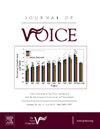Performance of Acoustic Measures for the Discrimination Among Healthy, Rough, Breathy, and Strained Voices Using the Feedforward Neural Network
IF 2.4
4区 医学
Q1 AUDIOLOGY & SPEECH-LANGUAGE PATHOLOGY
引用次数: 0
Abstract
Objective
To identify and evaluate the best set of acoustic measures to discriminate among healthy, rough, breathy, and strained voices.
Methods
This study used the vocal samples of the sustained /ε/ vowel from 251 patients with the vocal complaints, among which 51, 80, 63, and 57 patients exhibited healthy, rough, breathy, and strained voices, respectively. Twenty-two acoustic measures were extracted, and feature selection was applied to reduce the number of combinations of acoustic measures and obtain an optimal subset of measures according to the information gain attribute ranking algorithm. To classify signals as a function of predominant voice quality, a feedforward neural network was applied using a Levenberg-Marquardt supervised learning algorithm.
Results
The best results were obtained from 11 combinations, with each combination presenting six acoustic measures. Kappa indices ranged from 0.7527 to 0.7743, the overall hit rates are 81.67%-83.27%, and the hit rates of healthy, rough, breathy, and strained voices are 74.51%-84.31%, 78.75%-90.00%, 85.71%-98.41%, and 68.42%-82.46%, respectively.
Conclusions
We obtained the best results from 11 combinations, with each combination exhibiting six acoustic measures for discriminating among healthy, rough, breathy, and strained voices. These sets exhibited good Kappa performance and a good overall hit rate. The hit rate varied between acceptable and good for healthy voices, acceptable and excellent for rough voices, good and excellent for breathy voices, and poor and good for strained voices.
利用前馈神经网络辨别健康、粗糙、有气和紧张声音的声学测量性能
目的方法:本研究使用了 251 位嗓音不适患者的声带样本,其中 51、80、63 和 57 位患者的嗓音表现为健康、粗糙、带气和紧张:本研究使用了 251 名嗓音不适患者的持续元音 /ε/ 的发声样本,其中分别有 51、80、63 和 57 名患者表现出健康嗓音、粗糙嗓音、喘息嗓音和紧张嗓音。提取了 22 个声学测量值,并根据信息增益属性排序算法进行了特征选择,以减少声学测量值的组合数量并获得最佳测量值子集。为了根据主要语音质量对信号进行分类,采用了 Levenberg-Marquardt 监督学习算法的前馈神经网络:11 种组合获得了最佳结果,每种组合都有六种声学测量方法。卡帕指数在 0.7527 到 0.7743 之间,总体命中率为 81.67%-83.27%,健康声、粗糙声、喘息声和紧张声的命中率分别为 74.51%-84.31%、78.75%-90.00%、85.71%-98.41% 和 68.42%-82.46%:我们从 11 种组合中获得了最佳结果,每种组合都有六种声学测量方法,用于区分健康声、粗糙声、喘息声和紧张声。这些组合表现出良好的 Kappa 性能和较高的总体命中率。健康嗓音的命中率介于可接受和良好之间,粗糙嗓音的命中率介于可接受和优秀之间,喘息嗓音的命中率介于良好和优秀之间,紧张嗓音的命中率介于较差和良好之间。
本文章由计算机程序翻译,如有差异,请以英文原文为准。
求助全文
约1分钟内获得全文
求助全文
来源期刊

Journal of Voice
医学-耳鼻喉科学
CiteScore
4.00
自引率
13.60%
发文量
395
审稿时长
59 days
期刊介绍:
The Journal of Voice is widely regarded as the world''s premiere journal for voice medicine and research. This peer-reviewed publication is listed in Index Medicus and is indexed by the Institute for Scientific Information. The journal contains articles written by experts throughout the world on all topics in voice sciences, voice medicine and surgery, and speech-language pathologists'' management of voice-related problems. The journal includes clinical articles, clinical research, and laboratory research. Members of the Foundation receive the journal as a benefit of membership.
 求助内容:
求助内容: 应助结果提醒方式:
应助结果提醒方式:


